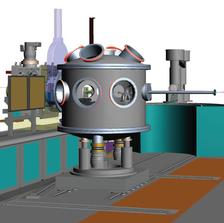3D representation of the DAC setup at the HED instrument of the European XFEL. The dynamic DAC with sample stack is located in a vacuum chamber. The vacuum chamber is positioned on a manual rail system to move the DAC setup in and out of the beam. The detector bank downstream from the chamber holds an AGIPD 1 M and two PE XRD 4343 ct for the detection of diffraction images. The detector bank is fully motorized. Behind the DAC vacuum chamber is indicated the position of the diffractometer for pulsed magnetic studies also positioned on a manual operating rail system. (Image: DESY)
Workpackage 5: H. P. Liermann (DESY)
Research related to phenomena created in dynamic operated Diamond Anvil Cells (DACs) have become one of the new experimental fields in static high-pressure research over the last decade. During this time 3rd generation light sources have optimized their experimental and analytical capabilities to conducted time resolved experiments achieving repetition rates in the kHz regime.
However, many of the new ideas that are emerging when conducting compression rate dependent experiments, like kinetic studies, cannot be further explored by using existing high-pressure beamlines at synchrotron radiation sources. Therefore DESY is involved in the HIBEF consortium to extend its in-house research and already existing actitivties at the Extreme Conditions Beamline (ECB, P02.2) at PETRA III at DESY. The goal is to explore and expend time resolved diffraction capabilities at hard X-ray XFEL’s and particularly at the European XFEL. Several research areas will benefit significantly from the time resolved capabilities at the HED instrument of the European XFEL. They are described in the CDR for this subproject in detail:
Scientific goals and ideas using DACs at the European XFEL
- Exploration of physical properties and stabilities of phases at the pressure/temperature condition of the interior of extrasolar planets (rocky as well as gaseous) currently not accessible with conventional static high-pressure conditions created in the DAC
- Investigation of compression rate dependence on physical properties and stability of phases in the strain rate regime above 10-1/s to 104/s that can currently not be accessed at 3rd generation light sources, nor with shock compression at 4th generation sources.
- Exploring stellar interiors and fusion under warm dense matter (WDM) conditions in the isochoric heated DAC
- Thermal properties, like thermal diffusivity, of mineral and melts at earth and other planetary core conditions via spectroscopy and X-ray diffraction
- Study early stages of melting as well as crystallization/phase separation processes at dynamic conditions through phase contrast imaging (PCI) and diffraction in normal and radial geometry in the DAC
In January 2016 interested parties from the 'static DAC' community came together for a workshop to discuss in more detail the possible science cases for a DAC setup and the technical requirements and possible implementation. This was summarized in the Conceptual Design Report (CDR). The CDR was endorsed by the Scientific Advisory Committee (SAC) and the Technical Advisory Committee (TAC) of HIBEF and finally approved by the HIBEF management board in November 2016.
Since then a team of engineers and scientists (DESY, HZDR and European XFEL) from the different Workpackages, together with external advisory team, are working on implementing technical details for the setup. This should be summarized in a Technical Design Report (TDR) in summer of 2017 for the endorsement by the SAC/TAC and approval of the management board of HIBEF. The key developments include a vacuum chamber, for dual use of DAC and shock compression, and a 1 M GaAs AGIPD detector, from the DESY Detector Group. These developments will enable to probe fast compressed materials with X-ray diffraction in the DAC at a repetition rate of 4.5 MHz, which is the fastest that the XFEL can produce X-ray pulses.








